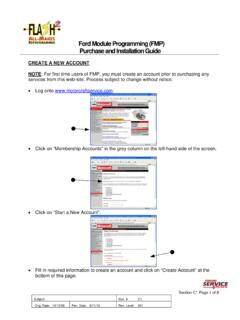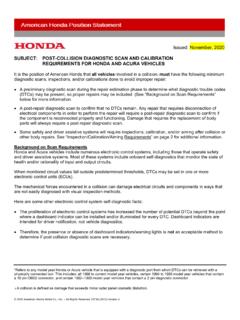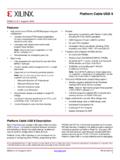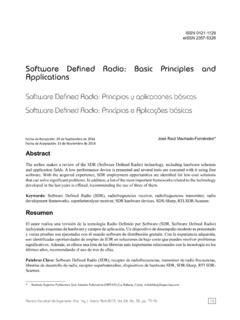Transcription of Software Reprogramming for Cyber Electromagnetic Activities
1 Army Regulation 525 15 Military OperationsSoftwareReprogramming forCyberElectromagneticActivitiesHeadqua rtersDepartment of the ArmyWashington, DC19 February 2016 UNCLASSIFIEDSUMMARY of CHANGEAR 525 15 Software Reprogramming for Cyber Electromagnetic ActivitiesThis major revision, dated 19 February 2016--o Changes the title from Software Reprogramming for Electronic Warfare andTarget Sensing Systems to Software Reprogramming for Cyber ElectromagneticActivities (cover).o Introduces expanded scope for Software Reprogramming support to cyberelectromagnetic Activities (chap 1).o Adds responsibilities for Headquarters, Department of the Army, commands, anddirect reporting units to provide support for electronic warfarereprogramming mission requirements (chap 2).
2 O Establishes Cyber Electromagnetic Activities Software reprogrammingintegration and interoperability implementation strategy (chap 3).HeadquartersDepartment of the ArmyWashington, DC19 February 2016 Military OperationsSoftware Reprogramming for Cyber Electromagnetic Activities *Army Regulation 525 15 Effective 19 March 2016H i s t o r y . T h i s p u b l i c a t i o n i s a m a j o u m m a r y . T h i s r e g u l a t i o n s e t s f o r t hArmy policy for Software reprogrammingfor electronic warfare and target sensings y s t e m s . I t c o v e r s m a n a g e r i a l r e q u i r e -ments necessary to implement electronicwarfare and target sensing systems opera-tions and training oversight for actions inpeacetime and wartime, to include reserve modes in order to admin-ister counter threat changes.
3 It establishesr e s p o n s i b i l i t y f o r A r m y c o u n t e r - t h r e a t -change This regulation applies tot h e A c t i v e A r m y , t h e A r m y N a t i o n a lGuard/Army National Guard of the UnitedStates, and the Army Reserve, unlessotherwise stated. It also applies to all pro-ponent agencies involved in research anddevelopment, acquisition, life cycle sup-p o r t , i n t e l l i g e n c e , p l a n n i n g a n d i n t e g r a -tion, and operations Activities of electronicw a r f a r e a n d t a r g e t s e n s i n g s y s t e m and exception proponent of this regulation is Dep-uty Chief of Staff, G 3/5/7.
4 The propo-n e n t h a s t h e a u t h o r i t y t o a p p r o v eexceptions or waivers to this regulationthat are consistent with controlling lawand regulations. The proponent may dele-gate this approval authority, in writing, toa d i v i s i o n c h i e f w i t h i n t h e p r o p o n e n tagency or its direct reporting unit or fieldoperating agency, in the grade of colonelor the civilian equivalent. Activities mayrequest a waiver to this regulation by pro-v i d i n g j u s t i f i c a t i o n t h a t i n c l u d e s a f u l lanalysis of the expected benefits and musti n c l u d e f o r m a l r e v i e w b y t h e a c t i v i t y ssenior legal officer.
5 All waiver requestswill be endorsed by the commander ors e n i o r l e a d e r o f t h e r e q u e s t i n g a c t i v i t yand forwarded through their higher head-quarters to the policy proponent. Refer toAR 25 30 for specific internal control process. Thisregulation contains internal control provi-sions in accordance with AR 11 2 andidentifies key internal controls that mustbe evaluated (see appendix B).S u p p l e m e n t a t i o n . S u p p l e m e n t a t i o n o fthis regulation and establishment of com-mand and local forms are prohibited with-out prior approval from the Deputy Chiefof Staff, G 3/5/7 (DAMO ODE), Wash-ington, DC 20310 improvements.
6 Users areinvited to send comments and suggestedimprovements on DA Form 2028 (Recom-m e n d e d C h a n g e s t o P u b l i c a t i o n s a n dBlank Forms) directly to the Deputy Chiefof Staff, G 3/5/7 (DAMO ODE), Wash-ington, DC 20310 This regulation is availablein electronic media only and is intendedfor command levels C, D, and E for theActive Army, the Army National Guard/A r m y N a t i o n a l G u a r d o f t h e U n i t e dStates, and the Army (Listed by paragraph and page number)Chapter 1 Introduction, page 1 Purpose 1 1, page 1 References 1 2, page 1 Explanation of abbreviations and terms 1 3, page 1 Responsibilities 1 4, page 1 Program objectives 1 5, page 1 Chapter 2 Responsibilities, page 2 Assistant Secretary of the Army (Acquisition, Logistics and Technology)
7 2 1, page 2*This regulation supersedes AR 525 15, dated 23 August 525 15 19 February 2016iUNCLASSIFIEDC ontents ContinuedChief Information Officer/G 6 2 2, page 2 Chief, National Guard Bureau 2 4, page 2 Deputy Chief of Staff, G 2 2 5, page 2 Deputy Chief of Staff, G 3/5/7 2 6, page 3 Deputy Chief of Staff, G 4 2 7, page 4 Deputy Chief of Staff, G 8 2 8, page 4 Chief, Army Reserve 2 9, page 4 Commanding General, Army Materiel Command 2 10, page 4 Commanding General, Forces Command 2 11, page 5 Commanding General, Army Training and Doctrine Command 2 12, page 5 Commanders, Army service component commands 2 13, page 5 Commanding General, Army Test and Evaluation Command 2 14, page 6 Commanding General, Second Army 2 15, page 6 Commanding General, Army Cyber Command 2 16, page 6 Commanders of Army service component commands serving geographic combatant commands and Joint task forces 2 17, page 6 Chapter 3 Counter-Threat-Change Strategic Overview, page 6 New and changed threats 3 1, page 6 Rapid Software Reprogramming strategy 3 2, page 7 Evolving Army practices 3 3, page 7 Commander s response to changes in threat-system Electromagnetic parameters.
8 Procedures and modes of operation 3 4, page , page Control Evaluation, page 9 GlossaryiiAR 525 15 19 February 2016 Chapter 1 Introduction1 1. PurposeThis regulation establishes policy, assigns responsibilities, and provides strategy for integration and interoperability ofcyber Electromagnetic Activities (CEMA). CEMA consist of cyberspace operations, electronic warfare (EW), andspectrum management operations. This policy emphasizes CEMA EW systems conducting electronic attack (EA),electronic warfare support (ES), and electronic protection (EP) through rapid Software Reprogramming (RSR). It is theArmy policy for CEMA EW mission Software products (MSPs) and Mission Enabling Software (MES).
9 MSP includeaviation survivability equipment Software , mission data sets, and ground-based counter-improvised explosive devicesoftware, known as threat load sets, and nonmission Software products such as the Army Reprogramming AnalysisTeam (ARAT) survivability Software loader development and distribution. It describes the operation of Army capabilityto identify and counter changes to threat system composition, capabilities and signatures within the electromagnetics p e c t r u m ( E M S ) a n d c o o r d i n a t e d w i t h s p e c t r u m m a n a g e m e n t o p e r a t i o n s . M E S e n c o m p a s s e s a l l o t h e r A r m yReprogramming Analysis Team Program Office (ARAT PO) products, for example, computer based training, systemsoftware support and maintenance, pattern developments, and CEMA threat verification and validation.
10 The Armycreates effective countermeasures to hostile introduction of new CEMA threat systems and changes that impact theArmy s ability to detect, classify, declare, and counter the threat. The development of these countermeasures enhancessecurity and preservation of friendly forces and equipment. This policy gives the Army a process which enablessoldiers a reach-back RSR capability that will assist commanders to attain tactical superiority, achieve surprise, gainand retain the initiative, maintain awareness of new and emerging threats, and obtain decisive results while maintainingvigilant data collection efforts to detect introduction of new threat signals or changes to existing threats through theRSR of CEMA 2.



















